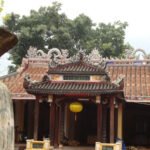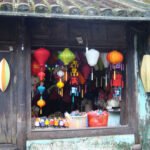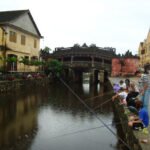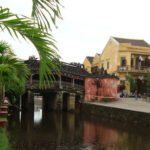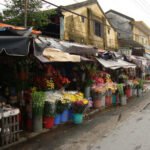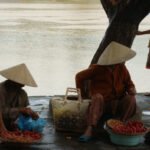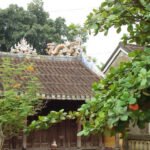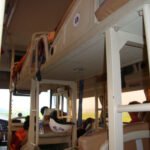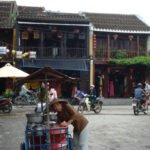Two Backpacks
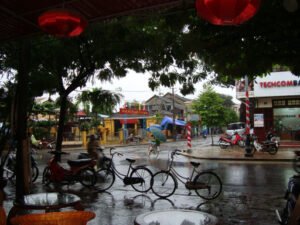
Chapter 17 - Oh, for a bigger backpack! Hoi An, Vietnam
It’s early September; Ron and I have been travelling for six months. We’ve experienced highs and lows, been heartbroken by tales of poverty and pain and had our spirits lifted by the generosity of those we’ve met on our journey.
The next leg of our Southeast Asia trip is to Hoi An, twelve hours away. It will be the first time we’ve travelled overnight on a sleeper bus.
With our bags safely stowed in the cavernous luggage compartment, Ron and I climb onboard the bus, eager to see how we’ll be travelling.
On board, we discover two tiers of ‘beds’ and, in place of the usual seats, small narrow bunks, three to a row along the length of the bus. On top of each bunk is a tiny pillow and a thin blanket.
‘I think these are built for the Asian population,’ complains Ron as he tries to wriggle onto his lower bunk. ‘There’s no way I can stretch out. I’ll have to sleep on my side with my legs bent,’ he complains.
I’m two or three inches shorter than Ron, and even I’m having difficulty inserting myself onto the narrow bed next to Ron. I shove my small bag beneath the headrest and shuffle around, trying to get comfortable.
‘I’m not sure we’ll get much sleep tonight. Perhaps saving on hotel accommodation wasn’t a good idea after all.’ Ron’s not happy, concerned that the cramped conditions will cause back problems once he can move again.
‘Try to relax. There’s nothing we can do now,’ I say, trying to calm him but equally worried about the impact the journey will have on the damaged disks in his spine.
‘I’ve got a bottle of Rescue Remedy in my bag. Why don’t you take a couple of drops? It’ll help you relax. You might get a few hours’ sleep,’ I suggest.
Ten minutes later, as the bus pulls out of the Nha Trang terminal, Ron’s already asleep, muffled snuffling sounds coming from beneath his blanket.
The bus driver stops along the way to pick up and drop off passengers; the stops are just long enough to dash to the toilet or buy snacks.
We arrive on the outskirts of Hoi An in the early afternoon. A tuk-tuk, sent by the hotel’s management, waits when we alight from the bus.
Our modern hotel has a pool, spacious rooms, and a free bus that runs hourly between the hotel and the town centre; the luxury is just what I need after two weeks of travel.
After an early night, Ron and I catch the hotel bus into Hoi An the following morning.
The city is a UNESCO World Heritage site, and the streets of the old town are narrow and intriguing. We wander the streets, peering into shop windows and doorways, stopping occasionally when a particular item catches my eye.
‘You can look, but remember, whatever you buy, you’ve got to carry in your pack,’ Ron warns as I hold up an intricately carved wooden statue.
He’s right; I’ve very little spare room in my pack, which is already heavy. I replace the statue and reluctantly move on to the next shop.
Hoi An is very much a tourist attraction, for besides the usual paraphernalia associated with the tourist trade, the town also boasts a thriving tailor trade. Coloured fabrics adorn the shop fronts while staff try to entice people into their stores.
I’d read about Hoi An in an Australian newspaper, how the cost of a flight, the inexpensive cost of buying tailor-made clothes and the fast service made it cheaper than buying dresses in Australia.
‘I’m going to buy a pair of jeans,’ I declared as we passed one such tailor shop. ‘What do you want?’ I asked Ron.
‘Nothing, I’ve got all the clothes I need. But you get something if you’re sure you want to,’ he replied, disinterested in nabbing a bargain.
The store assistant promised my jeans would be ready the following day, and with nothing more pressing than the opportunity to wander through the streets of this beautiful city, Ron and I did just that.
We walk along the Thu Bon River, crossing via the 17th-century Japanese Bridge, also known as Cau Pagoda. We pause on the bridge, a tiny haven of peace from this busy city’s daily hustle and bustle.
‘I read somewhere the bridge is connected to a Japanese legend, the monster Namazu; the Japanese believed it was Namazu’s movements that caused earthquakes and floods.’
‘Why did they name a bridge after something that causes such destruction?’ asks Ron, keen to hear more of the story I’d read in one of the travel guides I’d studied before setting off on our trip.
‘Well, people thought that the mythical monster’s head lay in India, its body in Vietnam and its tail in Japan. In Japanese mythology, the bridge is a magical sword pinning down Namazu’s body, preventing it from moving, causing natural disasters, and bringing peace and prosperity to the people of India, Vietnam and Japan.’
‘So, what are the dog and monkey doing at the entrance and exit of the bridge,’ asks Ron.
‘In Japanese culture, they symbolize protection and safety,’ I reply. ‘But they’re also thought to represent the year the building of the bridge started in the year of the Monkey and was finished in the year of the Dog.’
Ron seems satisfied with my answer and walks towards the tiny temple.
‘I’m hungry,’ he declares. ‘Let’s see if we can find something to eat in the Chinese quarter.’
We find a tiny street café and order white rose, rice noodles with shrimp and fried rice; it’s delicious and filling.
It’s dark when we leave the café. There’s rain in the air again. We catch a tuk-tuk back to the hotel for an early night and, hopefully, a brighter day tomorrow.
**********
Our hopes for a clear, dry day disappear when we wake; rain is pounding our bedroom window.
‘I don’t think we’ll be able to do much sightseeing today,’ I murmur from beneath the bed covers.
‘You’ve got to pick up your jeans this morning. So, how about we catch the hotel bus into town, find somewhere for breakfast and then collect your jeans? Maybe the rain will have stopped by the time we leave,’ suggests Ron.
We find an excellent café in the city’s centre, with a friendly, laid-back vibe and a menu that has my tummy rumbling – bacon, eggs and hash browns. The smell of freshly brewed coffee greets me as I push open the door, together with the gravelly strains of Leonard Cohen singing In My Secret Life.
Lost in good food and wonderful music, I order more coffee, and we spend the morning relaxing.
‘I suppose we’d better make a move. It’s time to pick up my jeans,’ I say to Ron, who’s reading a book on the history of Vietnam that he’s found in the book exchange at the café.
We pay our bill and walk five minutes to the tailor’s shop where I collect my jeans, at fifteen dollars Australian, a real bargain. Our next stop is the bus station, where we book seats for the bus to Hue tomorrow.
Back in our hotel, we settle in for a quiet evening. It’s pointless venturing out as the rain is still falling.
‘Let’s hope it’s stopped by the time we reach Hue. I don’t fancy traipsing around in the pouring rain anymore. My skin’s getting waterlogged!’ I state before curling up on the bed and reading about our next destination, Hue.
